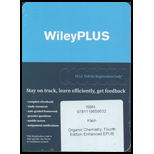
Concept explainers
(a)
Interpretation: A name for given compound needs to be assigned.

Concept Introduction: Nomenclature of
First method- Parent
Second method: Oxirane ring is considered as parent and groups attached to it are considered as substituents.
(b)
Interpretation: A name for given compound needs to be assigned.

Concept Introduction: Nomenclature of epoxides: Epoxides are cyclic ethers having an oxygen atom incorporated in three-membered ring system having up to four R groups. Due to ring strain, they are more reactive than other ethers. The simplest epoxide does not have any R group and known as ethylene oxide. Naming is done by two methods.
First method- Parent alkane chain is identified and oxygen is considered as substituent on that chain. Location of epoxide group is written with two numbers with suffix epoxy. While naming, epoxy substituents are alphabetically arranged.
Second method: Oxirane ring is considered as parent and groups attached to it are considered as substituents.
(c)
Interpretation: A name for given compound needs to be assigned.
Concept Introduction: Nomenclature of epoxides: Epoxides are cyclic ethers having an oxygen atom incorporated in three-membered ring system having up to four R groups. Due to ring strain, they are more reactive than other ethers. The simplest epoxide does not have any R group and known as ethylene oxide. Naming is done by two methods.
First method- Parent alkane chain is identified and oxygen is considered as substituent on that chain. Location of epoxide group is written with two numbers with suffix epoxy. While naming, epoxy substituents are alphabetically arranged.
Second method: Oxirane ring is considered as parent and groups attached to it are considered as substituents.
Want to see the full answer?
Check out a sample textbook solution
Chapter 13 Solutions
ORGANIC CHEMISTRY-ACCESS PACKAGE
- Synthesize 2-Ethyl-3-methyloxirane from dimethyl(propyl)sulfonium iodide using the necessary organic or inorganic reagents. Draw the structures of the compounds.arrow_forwardSynthesize 2-Hydroxy-2-phenylacetonitrile from phenylmethanol using the necessary organic or inorganic reagents. Draw the structures of the compounds.arrow_forwardSynthesize N-Methylcyclohexylamine from cyclohexanol using the necessary organic or inorganic reagents. Draw the structures of the compounds.arrow_forward
- Synthesize N-Methylcyclohexylamine from cyclohexanol using the necessary organic or inorganic reagents. Draw the structures of the compounds.arrow_forwardIf possible, please provide the formula of the compound 3,3-dimethylbut-2-enal.arrow_forwardSynthesize 1,4-dibromobenzene from acetanilide (N-phenylacetamide) using the necessary organic or inorganic reagents. Draw the structures of the compounds.arrow_forward
- Indicate the products obtained by mixing (3-oxo-3-phenylpropyl)triphenylphosphonium bromide with sodium hydride.arrow_forwardWe mix N-ethyl-2-hexanamine with excess methyl iodide and followed by heating with aqueous Ag2O. Indicate the major products obtained.arrow_forwardIndicate the products obtained by mixing acetophenone with iodine and NaOH.arrow_forward
- Indicate the products obtained by mixing 2-Propanone and ethyllithium and performing a subsequent acid hydrolysis.arrow_forwardIndicate the products obtained if (E)-2-butenal and 3-oxo-butanenitrile are mixed with sodium ethoxide in ethanol.arrow_forwardQuestion 3 (4 points), Draw a full arrow-pushing mechanism for the following reaction Please draw all structures clearly. Note that this intramolecular cyclization is analogous to the mechanism for halohydrin formation. COH Br + HBr Brarrow_forward
- Chemistry: Matter and ChangeChemistryISBN:9780078746376Author:Dinah Zike, Laurel Dingrando, Nicholas Hainen, Cheryl WistromPublisher:Glencoe/McGraw-Hill School Pub Co
 Chemistry for Today: General, Organic, and Bioche...ChemistryISBN:9781305960060Author:Spencer L. Seager, Michael R. Slabaugh, Maren S. HansenPublisher:Cengage Learning
Chemistry for Today: General, Organic, and Bioche...ChemistryISBN:9781305960060Author:Spencer L. Seager, Michael R. Slabaugh, Maren S. HansenPublisher:Cengage Learning Chemistry: Principles and PracticeChemistryISBN:9780534420123Author:Daniel L. Reger, Scott R. Goode, David W. Ball, Edward MercerPublisher:Cengage Learning
Chemistry: Principles and PracticeChemistryISBN:9780534420123Author:Daniel L. Reger, Scott R. Goode, David W. Ball, Edward MercerPublisher:Cengage Learning


